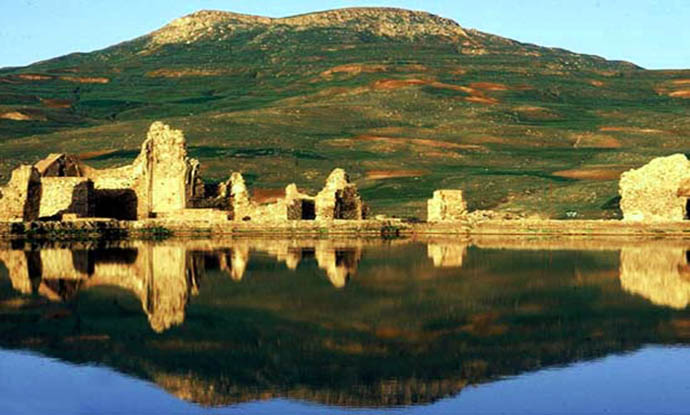
Highly ruins of the ancient city lie in mountains in the north of Iran. There was the main sanctuary of one of pre-Islamic religions. It magicians came to bow to the baby Christ from here. Ancient history reveals the secrets. Takht-e-Soleyman it was open in 1819 and remained almost unexplored till 1959. In the center of the destroyed city of Shiz built during an era Sasanidov there is a big lake with a diameter of 100 m. Mongols called this city of Saturik, and now it is known under a name Takht-e-Soleyman (“Solomon’s Throne”). The strong mineralization of water in the lake which was considered bottomless led to the fact that during the millennia the stratifications which created stone steep walls boards around the lake were formed there. This artificial bed leaves deep into on 40 m. In pre-Islamic times the mysterious and beautiful lake and its vicinities were considered as the main religious shrine of Iran. In 1959 thanks to the excavation which is carried out by the German Archaeological institute it was established that Takht-e-Soleyman was the sacred center of Zoroastrianism. This ancient religion is based on belief in eternal fight between god creator and spirit of the evil. Three magician, or the magician which as it is considered, came from the Iranian Sevekh to Bethlehem to bow to the baby Jesus, were probably Zoroastrian priests (initially magicians were called representatives of one of northwest Iranian tribes). From there is also a word “magic” which once described religious ceremonies of Zoroastrians. Interrelation of Takht-e-Soleyman and Zoroastrianism – the important link connecting several thousands of present adherents of this religion to their past. Zoroastrians left Persia in the 8th century, escaping from religious prosecutions of Muslims. They managed to restore contacts with the Iranian supporters only in the 15th century. Today they are called by parsa (Persians) and they live generally in Pakistan and India. However their followers are scattered worldwide. History Takht-e-Soleyman is closely connected with emergence of Zoroastrianism, with life of ancient founders of Iran – arians (the word “Iran” is translated as “the earth arians”). Arias worshipped forces of nature, first of all fire and water as to their divine manifestations. Therefore the district around Takht-e-Soleyman where two powerful natural phenomena adjoin – the volcanoes and thermal lakes fed by keys was for them especially attractive. Approximately in 600 BC the Aryan priest Zaratushtra (called in Greek Zoroastr), considering himself as the prophet tried to reform religious doctrines and a numerous pantheon of arians. Having torn with orthodox beliefs, Zaratushtra based own religion – Zoroastrianism. In new religion there were beginnings of monotheism: Zaratushtra considered the master of wisdom of Akhura-Mazda as the Supreme god who was helped by less important deities. Its fight against the demon of the evil – Angro-Maynyyu – had to come to the end with a victory of good and wisdom eventually. Zaratushtra learned that the person himself has to decide whose he will side in this fight and that the soul of the person is waited by the Last Judgement in a next world. The new religion incorporated several important elements of old. Sacred was an Akhura-Mazda symbol – fire. He was supported both in temples, and in a home. Zoroastrians also did everything possible to avoid defilement of elements. It visually is confirmed by their relation to burial of the dead. The dead were forbidden to be dug in to the earth that not to pollute it. It was impossible and burn bodies – in order to avoid fire defilement. Instead Zoroastrians built the big, round, revetted with a stone towers called to a dakhma – “silence towers”. Naked bodies gave all the best above. The flown signature stamps left behind only bones, and sunshine “took away souls of the dead on the sky”. This ritual of a parsa is observed and today. In the 3rd century AD the dynasty of Sasanids came to the power in Iran. At the shah Ardashire I which belonged to priestly estate the Zoroastrianism became the state religion. Almost in each city, the village or the province of ancient Iran sacred fire was supported. Its divine flame burned in the temple of Fire of the settlement Takht-e-Soleyman. Today ruins of this temple are reflected in waters of the lake around which there was an ancient city. The shah from a dynasty of Sasanids Hosrov of I (513-579 years AD) reconstructed the temple of Fire and built the city in already well-known religious center. A little earlier the palace in Ktesifon, on the river Tiger grew. It was the fantastic palace, the national rumor considered it as work of genies. Then Hosrov of I constructed Takht-e-Soleyman as the place of pilgrimage and worship of gods. Hosrov’s plans of I differed in special gloss. In Takht-e-Soleyman the way for processions which went straight from a magnificent entrance at the main gate to the temple of Fire and further to the lake was paved. After a majestic ceremony of the crowning which was taking place in Ktesifon, Sasanid’s shahs went to worship to Takht-e-Soleyman to receive divine blessing before an altar of Imperial fire. However Hosrov of I could not expect that he happens in the near future. In 624 Takht-e-Soleyman was plundered by Mongols and though later they restored it, it never returned itself(himself) former glory any more. Imperial fire was extinguished. The Arab conquerors entered other state religion – Islam. Eventually, this splendid sanctuary finally fell into decay and was reduced to ruins.

Leave a Reply